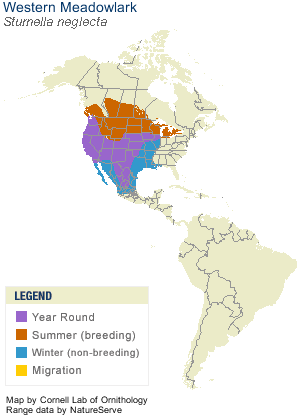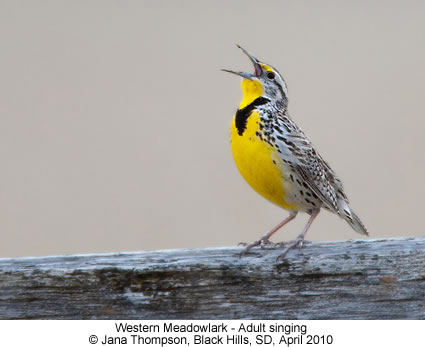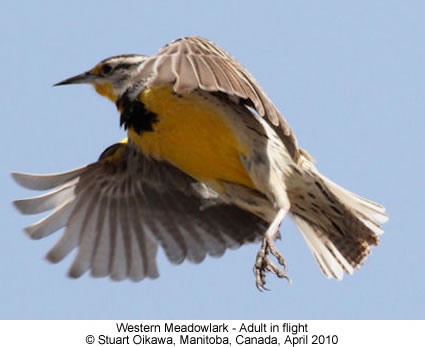|
The
buoyant, flutelike melody of the Western Meadowlark ringing out
across a field can brighten anyone’s day. Meadowlarks are often
more easily heard than seen, unless you spot a male singing from
a fence post. This colorful member of the blackbird family flashes
a vibrant yellow breast crossed by a distinctive, black, V-shaped
band. Look and listen for these stout ground feeders in grasslands,
meadows, pastures, and along marsh edges throughout the West and
Midwest, where flocks strut and feed on seeds and insects.
 Keys
to identification Keys
to identification
Size
& Shape
The Western Meadowlark is the size of a robin but chunkier and shorter-tailed,
with a flat head, long, slender bill, and a round-shouldered posture
that nearly conceals its neck. The wings are rounded and short for
the bird’s size and the tail is short, stiff, and spiky.
Color
Pattern
Western Meadowlarks have yellow underparts with intricately patterned
brown, black and buff upperparts. A black “V” crosses
the bright yellow breast; it is gray in winter. Contrasting stripes
of dark brown and light buff mark the head. The outer tail feathers
flash white in flight.
Behavior
Look for Western Meadowlarks foraging on the ground alone or, in
winter, in small, loose flocks. When flushed, Western Meadowlarks
fly low, wings below the horizontal, gliding and flapping with short,
stiff, quail-like wingbeats. In spring and summer, males sing out
from atop fence posts, bushes, power lines, and other high points.
Habitat
Western Meadowlarks seek the wide open spaces of native grasslands
and agricultural fields for spring and summer breeding and winter
foraging. Look for them among low to medium-height grasses more
so than in tall fields. They also occur along the weedy verges of
roads, marsh edges, and mountain meadows up to 10,000 feet.
|
Measurements
Both
Sexes
Length
6.3–10.2
in
16–26 cm
Wingspan
16.1
in
41 cm
Weight
3.1–4.1
oz
89–115 g
Relative
Size
About
the size of an American Robin, but with a shorter tail.
Other
Names
- Sturnelle
de l'Ouest (French)
- Triguera
de Occidente (Spanish)
|
Cool
Facts
- The
nest of the Western Meadowlark usually is partially covered
by a grass roof. It may be completely open, however, or it may
have a complete roof and an entrance tunnel several feet long.
- Although
the Western Meadowlark looks nearly identical to the Eastern
Meadowlark, the two species hybridize only very rarely. Mixed
pairs usually occur only at the edge of the range where few
mates are available. Captive breeding experiments found that
hybrid meadowlarks were fertile, but produced few eggs that
hatched.
- A
male Western Meadowlark usually has two mates at the same time.
The females do all the incubation and brooding, and most of
the feeding of the young.
- The
explorer Meriwether Lewis was the first to point out the subtle
differences between the birds that would eventually be known
as the Eastern and Western Meadowlarks, noting in June 1805
that the tail and bill shapes as well as the song of the Western
Meadowlark differed from what was then known as the “oldfield
lark” in the Eastern United States.
- John
James Audubon gave the Western Meadowlark its scientific name,
Sturnella (starling-like) neglecta, claiming that most explorers
and settlers who ventured west of the Mississippi after Lewis
and Clark had overlooked this common bird.
- In
1914, California grain growers initiated one of the earliest
studies of the Western Meadowlark’s diet to determine whether
the bird could be designated a pest species. Although they do
eat grain, Western Meadowlarks also help limit numbers of crop-damaging
insects.
- Like
other members of the blackbird, or icterid, family, meadowlarks
use a feeding behavior called “gaping,” which relies
on the unusually strong muscles that open their bill. They insert
their bill into the soil, bark or other substrate, then force
it open to create a hole. This gives meadowlarks access to insects
and other food items that most birds can’t reach.
- The
Western Meadowlark is the state bird of six states: Kansas,
Montana, Nebraska, North Dakota, Oregon, and Wyoming. Only the
Northern Cardinal is a more popular civic symbol, edging out
the meadowlark by one state.
 Habitat
- Grassland Habitat
- Grassland
Western Meadowlarks live in open grasslands, prairies, meadows,
and some agricultural fields ranging from sea level to 10,000 feet.
They avoid wooded edges and areas with heavy shrubs. In winter they
forage for seeds on nearly bare ground, in contrast to the Eastern
Meadowlark, which tends to feed in more vegetated areas.
Food
- Insects
Western Meadowlarks eat both grain and weed seeds along with insects.
They show a distinctly seasonal dietary pattern, foraging for grain
during winter and early spring, and for weed seeds in the fall.
In late spring and summer they probe the soil and poke beneath dirt
clods and manure piles seeking beetles, ants, cutworms, grasshoppers,
and crickets. As they forage, meadowlarks use a feeding behavior
called “gaping”—inserting their bill in the soil
or other substrate, and prying it open to access seeds and insects
that many bird species can’t reach. Western Meadowlarks occasionally
eat the eggs of other grassland bird species. During hard winters,
they may even feed at carcasses such as roadkill.
|
Nesting
Facts
Clutch
Size
5–6
eggs
Number
of Broods
1-2
broods
Egg
Length
1–1.3
in
2.5–3.3 cm
Egg
Width
0.7–0.9
in
1.9–2.2 cm
Incubation
Period
13–16
days
Nestling
Period
10–12
days
Egg
Description
White
profusely spotted with brown, rust, and lavender.
Condition
at Hatching
Eyes
closed, naked with pinkish orange skin and sparse pearl
gray down along the spine and above the eyes.
|
Nesting
- Nest
Description
Working
alone, the female Western Meadowlark uses her bill to shape a depression
in the soil into a cup-like shape, then lines the nest with soft,
dry grasses and the pliable stems of shrubs. Although some nests
are simple grass-lined bowls, Western Meadowlarks often use the
vegetation around the nest cup as an anchor to create a hoodlike,
waterproof dome over the nest by weaving together grass and shrub
stems. When finished the nest is 7–8 inches across, with a
cup that is 4–5 inches across and 2–3 inches deep. It
can take 6–8 days for the female to build the season’s
first nest. As the parents move back and forth from the nest they
create short “runways” into surrounding grasslands.
Nest
Placement - Ground
The female Western Meadowlark chooses a nest spot on the ground
in pasture, prairie or other grassland habitat. She seeks out a
small dip or depression such as a cow footprint, often shielded
by dense vegetation that can make the nest difficult to see.
Behavior
- Ground Forager
Flocks of the stout-bodied Western Meadowlark forage along the ground
in open fields, probing the soil for insects, grain and weed seeds.
When taking to the air, they fly in brief, quail-like bursts, alternating
rapid, stiff wingbeats with short glides. In spring, males establish
territories and chase intruders away in “pursuit flights”
that can last up to 3 minutes. You may see males competing over
territorial boundaries perform a “jump flight,” springing
straight up into the air several feet and fluttering their wings
over their back with their legs hanging limp below. Male Western
Meadowlarks can spend up to a month establishing and defending a
breeding territory before females arrive. Successful males typically
mate with two females during the breeding season, bringing food
to the nest once the chicks are hatched and noisily chasing intruders
away. Western Meadowlarks are extremely sensitive to humans when
nesting and will abandon a nest if they are disturbed while incubating
their eggs.
 Conservation
Status - Least Concern Conservation
Status - Least Concern
Although Western Meadowlarks are numerous, their breeding populations
have been declining throughout the U.S. and Canada at about 1 percent
per year since at least 1966. Declines may be due in part to conversion
of grassland breeding and wintering habitat to housing and agricultural
uses. Other factors affecting Western Meadowlark populations may
include pesticide uses, habitat degradation due to invasive plant
species, and fire suppression that alters native grasslands. Further
research is needed to determine how different management practices
in both native and planted grasslands affect both nesting success
and adult survival of Western Meadowlarks.
|




 Keys
to identification
Keys
to identification Habitat
- Grassland
Habitat
- Grassland Conservation
Status - Least Concern
Conservation
Status - Least Concern